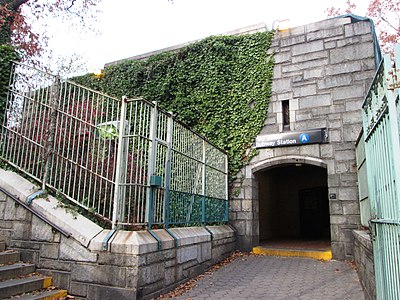190th Street station
The 190th Street station (originally 190th Street–Overlook Terrace) is a station on the IND Eighth Avenue Line of the New York City Subway, served by the A train at all times. It is located on Fort Washington Avenue in the Hudson Heights section of Manhattan's Washington Heights neighborhood, near the avenue's intersection with Cabrini Boulevard at Margaret Corbin Circle, about three blocks north of 190th Street.
190 Street
West 190th Street & Fort Washington Avenue
New York, NY
A ![]() (all times)
(all times)
Underground
140 feet (43 m)[2]
2
September 10, 1932[3]
![]() ADA-accessible to mezzanine only; platforms are not ADA-accessible
ADA-accessible to mezzanine only; platforms are not ADA-accessible
Yes
190th Street–Overlook Terrace
east side of Fort Washington Avenue, west side of Bennett Avenue
951,786[4] ![]() 22.6%
22.6%
301 out of 423[4]
New York City Subway System MPS
March 30, 2005
The 190th Street station opened in 1932 and has two tracks and two side platforms. It is close to Fort Tryon Park with the Cloisters medieval art museum, and the Mother Cabrini Shrine. An additional exit through the side of the hill leads to Bennett Avenue and provides access to the Broadway Valley area of Washington Heights. The station is listed on the National Register of Historic Places.
History[edit]
Construction and opening[edit]
New York City mayor John Francis Hylan's original plans for the Independent Subway System (IND), proposed in 1922, included building over 100 miles (160 km) of new lines and taking over nearly 100 miles (160 km) of existing lines. The lines were designed to compete with the existing underground, surface, and elevated lines operated by the Interborough Rapid Transit Company (IRT) and BMT.[6][7] On December 9, 1924, the New York City Board of Transportation (BOT) gave preliminary approval for the construction of the IND Eighth Avenue Line.[8] This line consisted of a corridor connecting Inwood, Manhattan, to Downtown Brooklyn, running largely under Eighth Avenue but also paralleling Greenwich Avenue and Sixth Avenue in Lower Manhattan.[8][9] The BOT announced a list of stations on the new line in February 1928, with a station at 190th Street.[10]
The BOT began constructing the 190th Street station in 1928. Squire J. Vickers, the chief architect of the Dual System, helped design the 190th Street station. He was responsible for most stations on the Independent Subway System (IND), and being a painter, he did tile work for the station.[5]: 9 Robert Ridgway was hired as the chief engineer.[5]: 10 The finishes at the five stations between 175th and 207th Street, including the 190th Street station, were 18 percent completed by May 1930.[11] By that August, the BOT reported that the Eighth Avenue Line was nearly completed and that the stations from 116th to 207th Street were 99.9 percent completed.[12] The entire line was completed by September 1931, except for the installation of turnstiles.[13]
A preview event for the new subway was hosted on September 8, 1932, two days before the official opening.[14][15] The 190th Street station opened on September 10, 1932, as part of the city-operated IND's initial segment, the Eighth Avenue Line between Chambers Street and 207th Street.[16][17] Construction of the whole line cost $191.2 million. Service at this station was provided with express service from its onset. While the IRT Broadway–Seventh Avenue Line already provided service to Washington Heights, the new subway via Fort Washington Avenue made subway service more readily accessible.[18] Its opening resulted in the development of residential apartment buildings south of the station.[5]: 10
Operation[edit]
On December 28, 1950, the Board of Transportation issued a report concerning the construction of bomb shelters in the subway system. Five deep stations in Washington Heights, including the 190th Street station, were considered to be ideal for being used as bomb-proof shelters. The program was expected to cost $104 million. These shelters were expected to provide limited protection against conventional bombs, while providing protection against shock waves and air blast, as well as from the heat and radiation from an atomic bomb. To become suitable as shelters, the stations would require water-supply facilities, first-aid rooms, and additional bathrooms.[19][20] However, the program, which required federal funding, was never completed.[21]
In 1951, researchers from New York University concluded that in the event of a nuclear attack, the 190th Street station would provide adequate shelter from fallout. This was ascertained after the researchers conducted tests on cosmic rays inside deep subway stations in the area.[22]
The 190th Street station is mostly unchanged from its original design.[5]: 8 On March 30, 2005, the 190th Street station was listed on the National Register of Historic Places (NRHP).[5] The station was considered historically and architecturally significant as an early IND station that retained many of its original features.[5]: 9 In 2023, the MTA began planning to renovate the Chambers Street and 190th Street stations for a combined $100 million; the work would involve "historically sensitive" repairs, as both stations are on the NRHP.[23][24] The project was to be funded by congestion pricing in New York City, but the renovation was postponed in June 2024 after the implementation of congestion pricing was delayed.[25]


